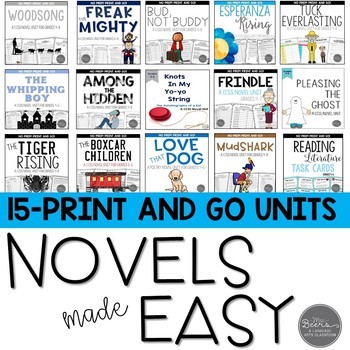Novel Study Unit Bundle: 15 No-Prep Units for Middle School - CCSS Aligned
- Zip
- Easel Activity
Products in this Bundle (18)
showing 1-5 of 18 products
Bonus
Description
If you are looking for the perfect resource to differentiate your reading instruction for grades 4-8, this is the bundle for you!
I struggled as a reading teacher to give my students the freedom they need as accountable, independent readers. They needed to be able to grow, self-select novels, and have the tools to enhance their learning. So I got to work reading and developing this CCSS aligned novel unit resource. I hope your students enjoy these units as much as mine have.
Ideas for Use:
1. Use this resource to help differentiate the novel reading taking place in your class.
2. Display novels and let students select which text they want to read.
3. Provide students with novels to read independently, in small groups, or as a whole class.
4. Print out novel units.
5. Let students get started with their novels and novel units.
6. Watch as your students become more accountable, independent readers.
Includes the following PRINT AND GO novel study units for you to implement immediately...
• Realistic Fiction: The Tiger Rising, Frindle, and Freak the Mighty
• Science Fiction: Pleasing the Ghost and Among the Hidden
• Historical Fiction: Esperanza Rising and Bud, Not Buddy
• Mystery: The Boxcar Children and Mudshark
• Autobiography: Knots In My Yo-yo String and Woodsong
• Poetry: Looking for Me…in this Great Big Family and Love That Dog
• Fantasy: The Whipping Boy and Tuck Everlasting
• Genre Posters for BIG KIDS
• Reading Literature Task Cards
• Reading Literature Chit Chat Cards
• End of Novel Project For Any Novel
Standards Covered:
RL.4.1, RL.4.3, RL.4.4, RL.4.5, RL.4.6
RL.5.1, RL.5.2, RL.5.3, RL.5.4, RL.5.5, RL.5.6
RL.6.1, RL.6.2, RL.6.3, RL.6.4, RL.6.5, RL.6.6
RL.7.1, RL.7.2, RL.7.3, RL.7.4, RL.7.5, RL.7.6
RL.8.1, RL.8.2, RL.8.3, RL.8.4, RL.8.5 ,RL.8.6
W.4.4, W.5.4, W.6.4, W.7.4, W.8.4
*********************************************************************
I would LOVE to hear your feedback on this product! By leaving feedback you earn points toward future purchases that will save you money! Also, be sure to FOLLOW me so you are aware of new resources as soon as they are posted!





